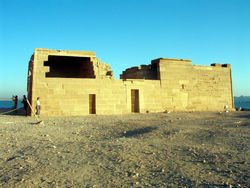
 |  |
|---|---|
 |  |
 |  |
 |
Dekka Temple is located about 100 kilometers south of the Aswan High Dam, the Temple of Dakka, dedicated to Thoth, the god of wisdom. It was moved to the site of el-Sebua, about 40 km upstream, between 1962 and 1968, because of the impendent flooding of the region as a result of the High Dam.
There are many different opinions about who built it. The temple was built by the Nubian Agher Amon who ruled at the time of King Ptolemy II, and later additions were added during the Greco-Roman times. But the temple is originally goes back to the 18th dynasty, during the time of Thutmosis III, Hatshepsut and Seti I and Merneptah.
During the construction of the Aswan dam in the 1960s, the temple was dismantled and moved to the site of Wadi es-Sebua. At the time of its removal, some reused stone blocks from Thutmose III, Seti I and Merneptah were discovered which originated from an earlier New Kingdom structure in or near Kubban. The temple's pylon is now separated from the remainder of the temple due to the missing enclosure walls of the open court.
El-Dakka was known to the Egyptians as Pselqet and to the Greeks as Pselchis. This Temple nowadays, sits on a small bluff. It consists of a facade, pylon, a courtyard and two sanctuaries. It is considered the only Nubian temple with a facade that faces to the north and oriented north-south to parallel the course of the Nile.
The pylon of the temple is now separated from the remainder of the temple due to the missing enclosure walls of the open court. Above the entrance of the pylon, a solar disk with a uraeus extends its wings. On the southern side of the temple, a small entrance leads into the interior of the pylon and to a stairway that communicates with several internal rooms.
After the open courtyard, the facade of the pronaosis adorned with reliefs of a Ptolemaic King sacrificing to various deities. Beyond the pronaos, the temple has two sanctuaries, one built by Arkamani and then a second one added by Augustus. It contains many reliefs which depicted the Nubian king making offerings to local gods of Aswan . Some of the best of these reliefs portray Anqet, the goddess of Aswan with her elaborate feathered headdress, and the lion-headed goddess Sekhmet. Other scenes depict the king making offerings to not only Thoth, but also Isis and Tefnut.
The temple is decorated with many religion scenes and important relief.Like most of the other Nubian monuments it was converted into a church during the Christian era.






